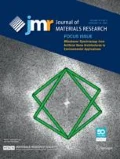Abstract
Instrumented indentation (referred to as nanoindentation at low loads and low depths) has now become established for the single point characterization of hardness and elastic modulus of both bulk and coated materials. This makes it a good technique for measuring mechanical properties of homogeneous materials. However, many composite materials are composed of material phases that cannot be examined in bulk form ex situ (e.g., carbides in a ferrous matrix, calcium silicate hydrates in cements, etc.). The requirement for in situ analysis and characterization of chemically complex phases obviates conventional mechanical testing of large specimens representative of these material components. This paper will focus on new developments in the way that nanoindentation can be used as a two-dimensional mapping tool for examining the properties of constituent phases independently of each other. This approach relies on large arrays of nanoindentations (known as grid indentation) and statistical analysis of the resulting data.
Similar content being viewed by others
References
M.F. Doerner and W.D. Nix: A method for interpreting the data from depth-sensing indentation instruments. J. Mater. Res. 1, 601 (1986).
J.L. Loubet, J.M. Georges, and G. Meille: Vickers indentation curves of elastoplastic materials, in Microindentation Techniques in Materials Science and Engineering, edited by P.J. Blau and B.R. Lawn (ASTM Intl., West Conshohocken, PA, 1986), p. 72.
W.C. Oliver and G.M. Pharr: An improved technique for determining hardness and elastic modulus using load and displacement sensing indentation experiments. J. Mater. Res. 7, 1564 (1992).
N.X. Randall, R. Christoph, S. Droz, and C. Julia-Schmutz: Localized micro-hardness measurements with a combined scanning force microscope/nanoindentation system. Thin Solid Films 291, 348 (1996).
G. Constantinides, F-J. Ulm, and K.J. Van Vliet: On the use of nanoindentation for cementitious materials. Mater. Struct. 36, 191 (2003).
F-J. Ulm, G. Constantinides, and F.H. Heukamp: Is concrete a poromechanics material? A multiscale investigation of poroelas-tic properties. Mater. Struct. 37, 43 (2004).
G. Constantinides and F-J. Ulm: The effect of two types of C-S-H on the elasticity of cement-based materials: Results from nanoindentation and micromechanical modeling. Cem. Concr. Res. 34, 67 (2004).
G. Constantinides, K.S.R. Chandran, F-J. Ulm, and K.J. Van Vliet: Grid indentation analysis of composite microstructure and mechanics: Principles and validation. Mater. Sci. Eng., A 430, 189 (2006).
G. Constantinides and F-J. Ulm: The nanogranular nature of C-S-H. J. Mech. Phys. Solids 55, 64 (2007).
F-J. Ulm, M. Vandamme, C. Bobko, J.A. Ortega, K. Tai, and C. Ortiz: Statistical indentation techniques for hydrated nanocom-posites: Concrete, bone, and shale. J. Am. Ceram. Soc. 90, 2677 (2007).
M. Vandamme and F-J. Ulm: The nanogranular origin of concrete creep: A nanoindentation investigation of microstructure and fundamental properties of calcium-silicate-hydrates, CEE Report R08–01 (Department of Civil and Environmental Engineering, Massachusetts Institute of Technology, Cambridge, MA, 2008).
G. Constantinides and F-J. Ulm: Invariant mechanical properties of calcium-silicate-hydrates (C-S-H) in cement-based materials: Instrumented nanoindentation and microporomechanical modeling, CEE Report R06–01 (Department of Civil and Environmental Engineering, Massachusetts Institute of Technology, Cambridge, MA, 2006).
K. Durst, M. Goken, and H. Vehoff: Finite element study for nanoindentation measurements on two-phase materials. J. Mater. Res. 19, 85 (2004).
A. Perriot and E. Barthel: Elastic contact to a coated half-space: Effective elastic modulus and real penetration. J. Mater. Res. 19, 600 (2004).
D.C. Hurley, M. Kopycinska-Müller, A.B. Kos, and R.H. Geiss: Nanoscale elastic-property measurements and mapping using atomic force acoustic microscopy. Meas. Sci. Technol. 16, 2167 (2005).
S.A. Asif, K.J. Wahl, R.J. Colton, and O.L. Warren: Quantitative imaging of nanoscale mechanical properties using hybrid nanoindentation and force modulation. J. Appl. Phys. 90(3), 1 (2001).
L. Dormieux, D. Kondo, and F-J. Ulm: Microporomechanics, 1st ed. (John Wiley & Sons, New York, NY, 2006).
A.V. Hershey: The elasticity of an isotropic aggregate of anisotropic cubic crystals. J. Appl. Mech. 21, 236 (1954).
E. Kröner: Calculation of the elastic constants of a polycrystal from the constants of the single crystal. Z. Phys. 151, 504 (1958).
International Organization for Standardization: ISO 14577, Metallic materials-Instrumented indentation test for hardness and materials parameters (International Organization for Standardization, 2007).
Author information
Authors and Affiliations
Corresponding author
Rights and permissions
About this article
Cite this article
Randall, N.X., Vandamme, M. & Ulm, FJ. Nanoindentation analysis as a two-dimensional tool for mapping the mechanical properties of complex surfaces. Journal of Materials Research 24, 679–690 (2009). https://doi.org/10.1557/jmr.2009.0149
Received:
Accepted:
Published:
Issue Date:
DOI: https://doi.org/10.1557/jmr.2009.0149




